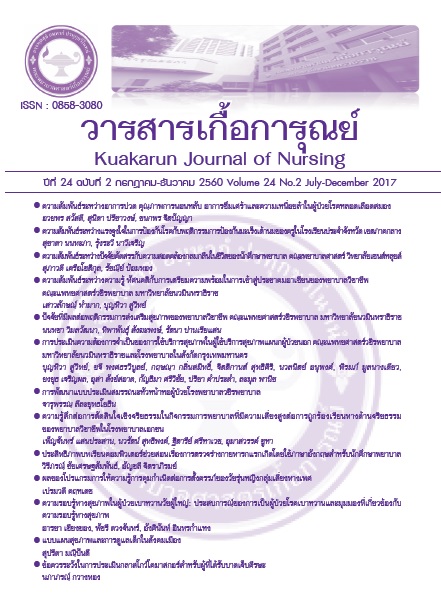Caution in Assessing Glasgow Coma Score for Head Injury
Main Article Content
Abstract
Abstract
Assessment of patients with head injury is very important as head injury is life threatening so it needs urgent assistance; otherwise the patient may die or
permanently disable. Level of consciousness should be assessed upon initial contact with the patient urgently properly and continually. Currently, Glasgow Coma Score has become the gold standard scale and is used internationally and widely for recording the conscious state of a person for initial as well as subsequent assessment. Nurses are caregivers constantly all the time and we are the most important person in consciousness assessment continued. We must have knowledge and expertise in assessing the Glasgow Coma Score and can solve problems in the assessment. Base on the author’s experience, sometimes found that there are many factors that cause ambiguous results and cannot define each level of eye opening, verbal response and motor response clearly. Therefore, the results are different particularly evaluating patients with head injury in various conditions that may result in ambiguous
assessments such as the elderly, low blood pressure, oxygen depletion, lower body temperature, low blood sugar, get a sedative or high blood alcohol. These conditions affect the functioning of the nervous system. It may be in ambiguous results. If nurses aware the caution in assessing Glasgow Coma Score for head injury. It will help to interpret the meaning of the score accurately and more confident in the assessment.
Article Details
References
files.wordpress.com/.../e0b8aae0b8a3e0b8b8e.
นลินี พสุคันธภัค, สายสมร บริสุทธิ์ และวันเพ็ญ ภิญโญภาสกุล. (2559). แนวทางการพยาบาล ผู้ป่วยโรคหลอดเลือดสมอง สำหรับพยาบาลทั่วไป. กรุงเทพฯ: ธนาเพรส.
บุญเลิศ มิตรเมือง. (ม.ป.ป.). คู่มือการปฏิบัติงานด้านประสาทศัลยศาสตร์ สำหรับแพทย์ใช้ทุนในโรงพยาบาลชุมพรเขตรอุดมศักดิ์และโรงพยาบาลชุมชน. สืบค้นเมื่อ 9 กันยายน 2559, จาก
https://sites.google.com/site/neurosun/neurosurgeryemergency.
พรทิพย์ สายสุด. (2009). การพยาบาลผู้ป่วยที่มีภาวะฉุกเฉินทางระบบประสาท. สืบค้นเมื่อ 9 กันยายน 2559, จาก http://www.slideshare.net/taem/taem10nurseneurologic-emergency
พิชาย รัตนดิลก ณ ภูเก็ต. (2558). รายงานปี 2558 ประเทศไทยได้ที่หนึ่งในโลกแห่งเรื่องความตายบนท้องถนน. สืบค้นเมื่อ 8 กันยายน 2559, จาก http://www.manager.co.th/AstvWeekend/ViewNews.aspx?NewsID=9580000134092.
วิบูลย์ เตชะโกศล. (2557). ประสิทธิผลของการพัฒนาระบบทางด่วนพิเศษในผู้ป่วยบาดเจ็บที่ศีรษะ. ศรีนครินทร์เวชสาร, 29(6), 524-529.
สวิง ปันจัยสีห์, นครชัย เผื่อนปฐม และกุลพัฒน์ วีรสาร. (2556). แนวทางเวชปฏิบัติกรณีสมองบาดเจ็บ. กรุงเทพฯ: ธนาเพรส.
สำนักโรคไม่ติดต่อ กรมควบคุมโรค กระทรวงสาธารณสุข. (2557). รายงานประจำปี 2557. สืบค้นเมื่อ 18 กันยายน 2559, จาก http://thaincd.com/document/file/download/
paper-manual/annual2014.pdf.
สำนักโรคไม่ติดต่อ กรมควบคุมโรค กระทรวงสาธารณสุข. (2557). สถานการณ์อุบัติเหตุทางถนนปี พ.ศ. 2557. สืบค้นเมื่อ 6 กันยายน 2559, จาก www.thaincd.com/document/file/
info/injured/ สถานการณ์%20อุบัติเหตุทางถนน420ปี%20พศ%202557.pdf.
สมศักดิ์ เทียมเก่า. (2012). มาตรกลาสโกวโคม่า (Glasgow Coma Scale: GCS). สืบค้นเมื่อ 8 กันยายน 2559, จาก http://haamor.com/th/มาตรกลาสโกวโคม่า/.

